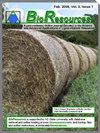Emissions and combustion characteristics of torrefied wood pellets
IF 1.6
4区 农林科学
Q2 MATERIALS SCIENCE, PAPER & WOOD
引用次数: 0
Abstract
The influence of torrefaction temperature on the durability, combustion characteristics, and emissions of CO, CO2, NOX, and particulate matter (PM) from biomass pellets was studied. The pellets were torrefied under inert conditions at 225, 250, and 300 °C for 60 min. Physical properties, such as weight loss, fines percentage, pellet durability index (PDI), and water absorption, were evaluated using ISO standards. The weight loss increased with higher torrefaction temperatures. Torrefied pellets had lower water absorption than untreated pellets. Fines percentage increased with torrefaction temperature while PDI decreased. Torrefied pellets at 300 °C had the lowest PDI (82.7%), while 225 °C had the highest (98.0%). The energy density and heating values increased with torrefaction temperature from 22.0 MJ/kg at 225 °C to 29.9 MJ/kg at 300 °C compared to 18.9 MJ/kg for untorrefied pellets. There were reductions in CO, CO2, and NOX emissions with an increase in torrefaction temperature while PM slightly reduced. This study found that torrefied biomass pellets had lower CO2 emissions than raw pellets.焙烧木质颗粒的排放和燃烧特性
研究了热解温度对生物质颗粒的耐久性、燃烧特性以及一氧化碳(CO)、二氧化碳(CO2)、氮氧化物(NOX)和颗粒物(PM)排放的影响。颗粒在 225、250 和 300 °C 的惰性条件下进行了 60 分钟的热解。采用 ISO 标准对重量损失、细粒百分比、颗粒耐久性指数 (PDI) 和吸水性等物理特性进行了评估。温度越高,重量损失越大。与未经处理的球团相比,经过热处理的球团吸水性更低。细粒百分比随热解温度的升高而增加,而 PDI 则下降。300 °C 下的热解颗粒的 PDI 最低(82.7%),而 225 °C 下的 PDI 最高(98.0%)。能量密度和发热值随着热解温度的升高而增加,从 225 °C 时的 22.0 兆焦/千克增至 300 °C 时的 29.9 兆焦/千克,而未经热解的颗粒为 18.9 兆焦/千克。随着烘干温度的升高,一氧化碳、二氧化碳和氮氧化物的排放量也有所减少,而可吸入颗粒物则略有减少。这项研究发现,经过热处理的生物质颗粒的二氧化碳排放量低于未经热处理的颗粒。
本文章由计算机程序翻译,如有差异,请以英文原文为准。
求助全文
约1分钟内获得全文
求助全文
来源期刊

Bioresources
工程技术-材料科学:纸与木材
CiteScore
2.90
自引率
13.30%
发文量
397
审稿时长
2.3 months
期刊介绍:
The purpose of BioResources is to promote scientific discourse and to foster scientific developments related to sustainable manufacture involving lignocellulosic or woody biomass resources, including wood and agricultural residues. BioResources will focus on advances in science and technology. Emphasis will be placed on bioproducts, bioenergy, papermaking technology, wood products, new manufacturing materials, composite structures, and chemicals derived from lignocellulosic biomass.
 求助内容:
求助内容: 应助结果提醒方式:
应助结果提醒方式:


